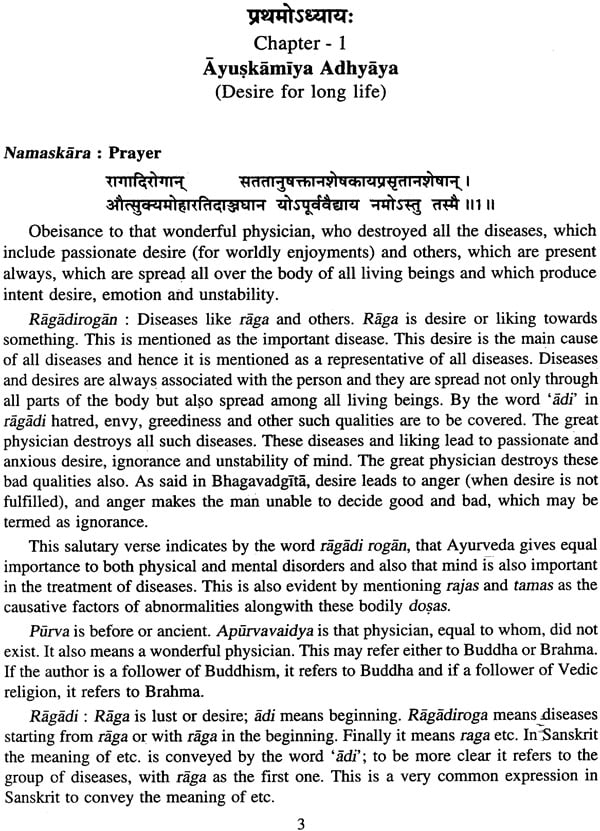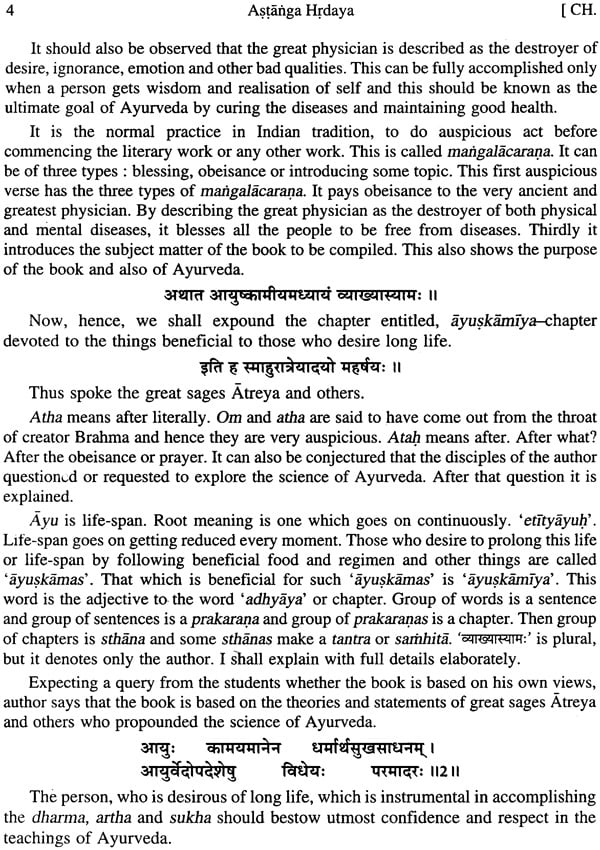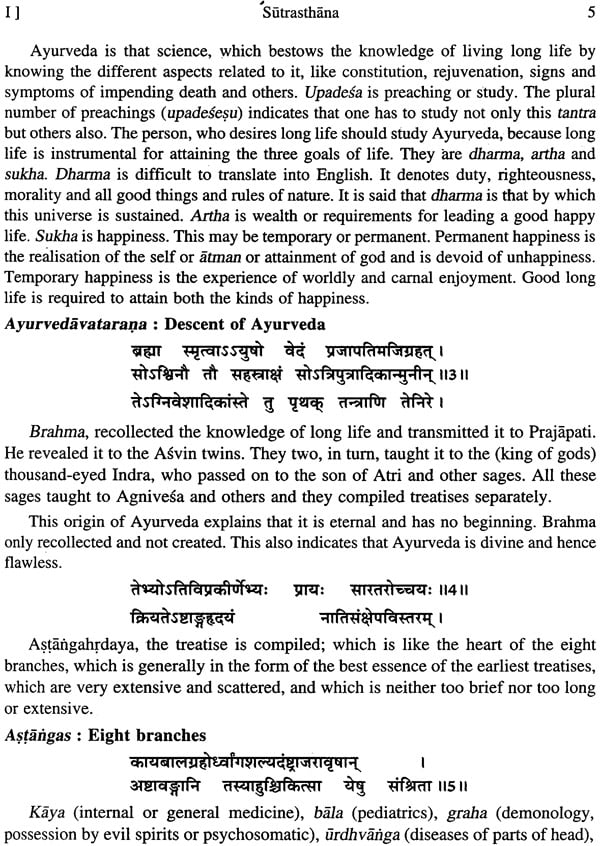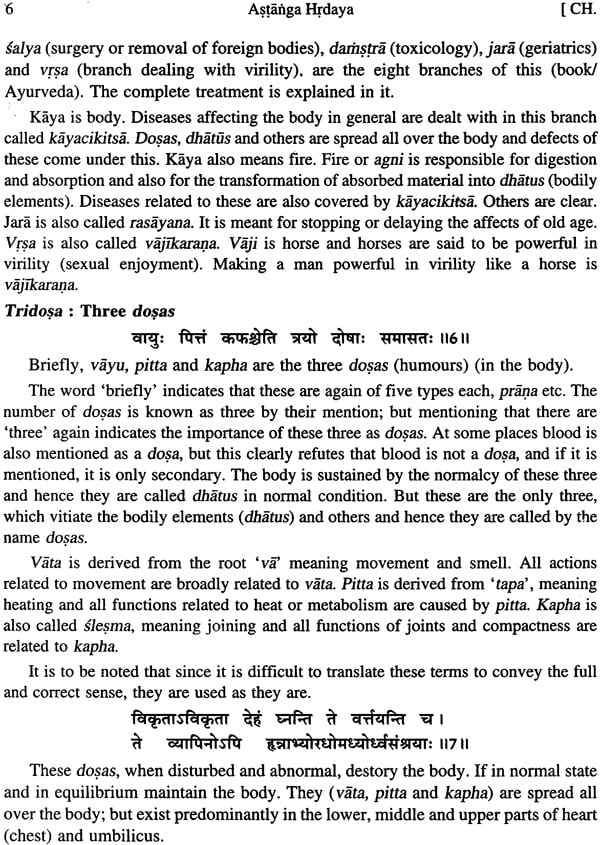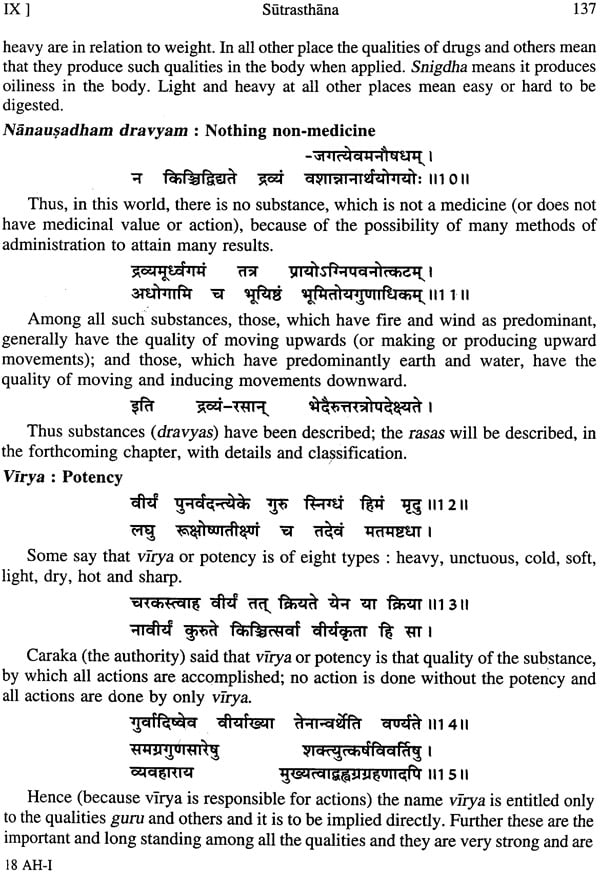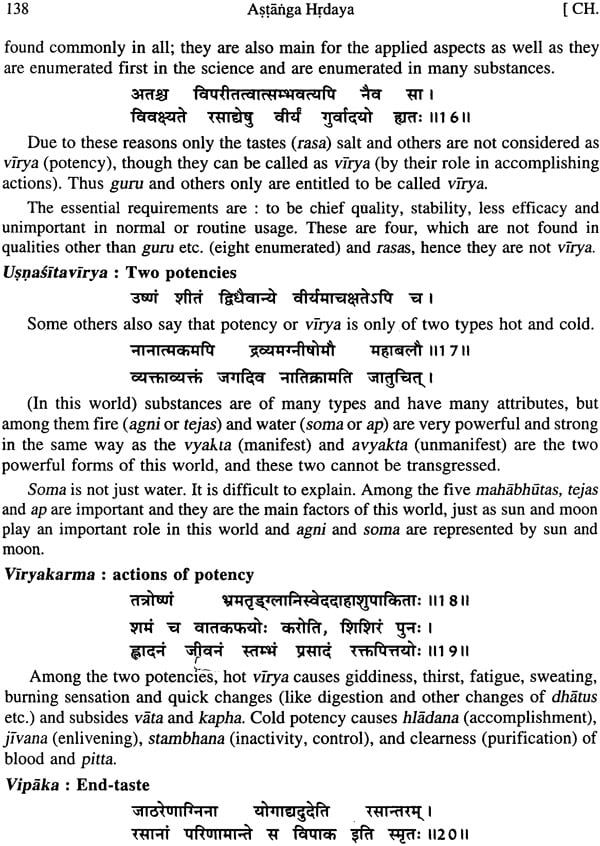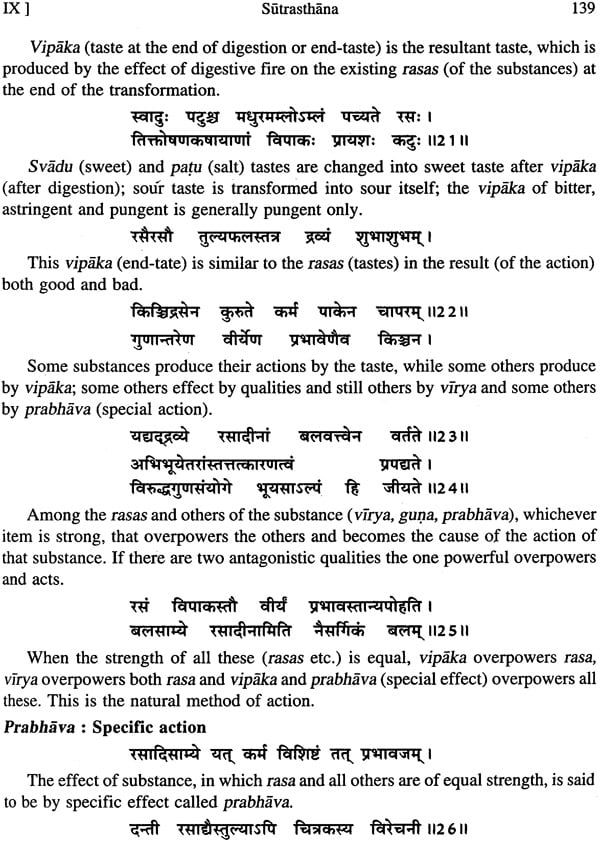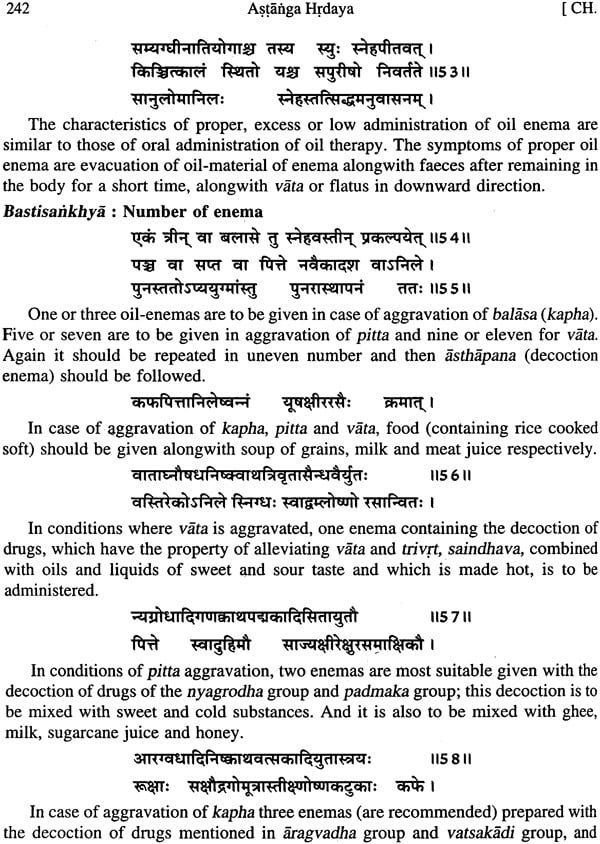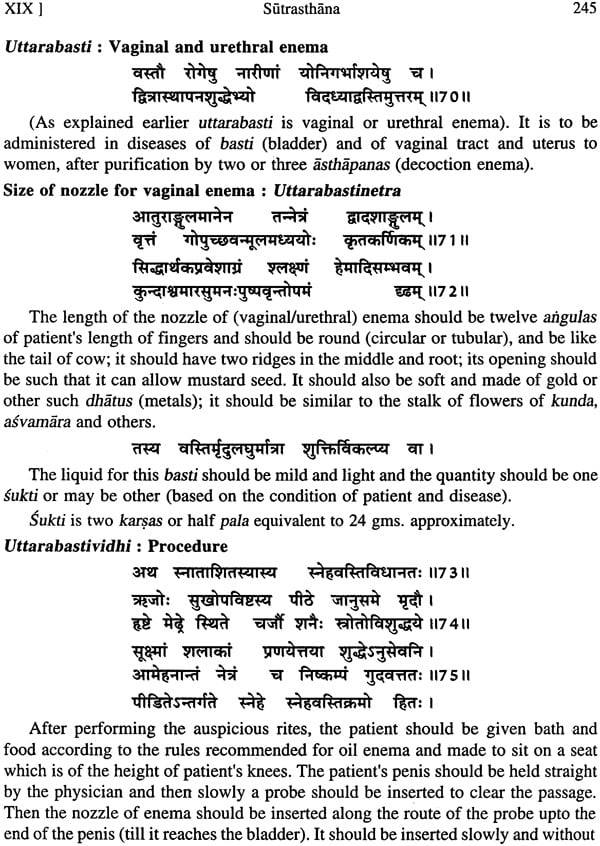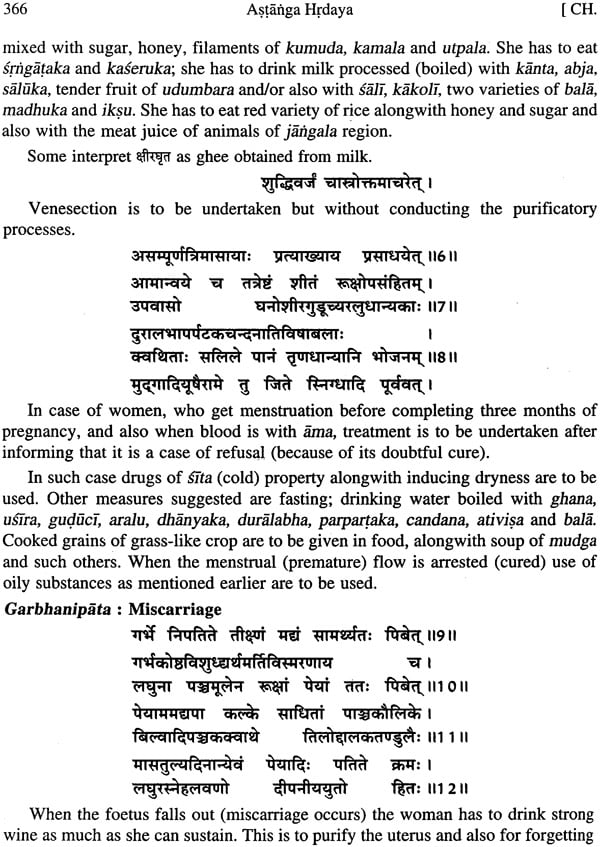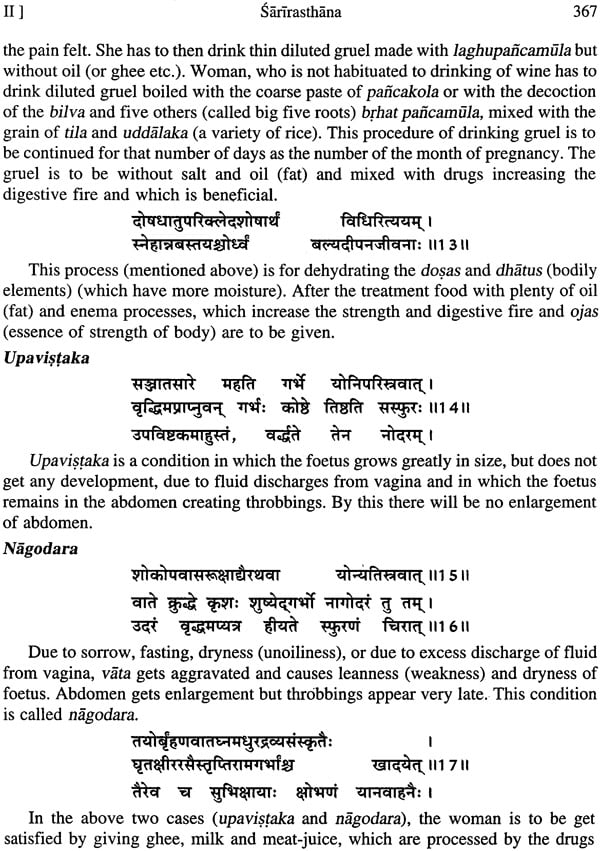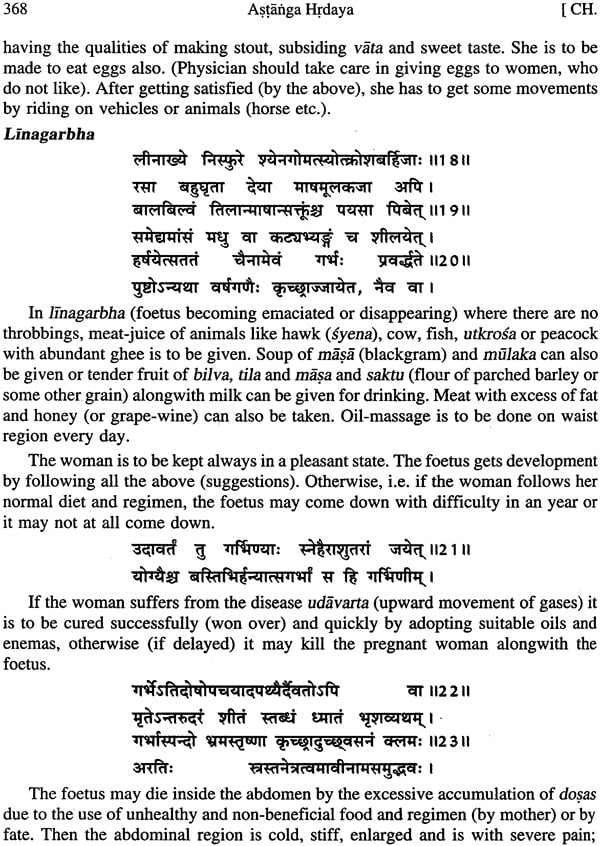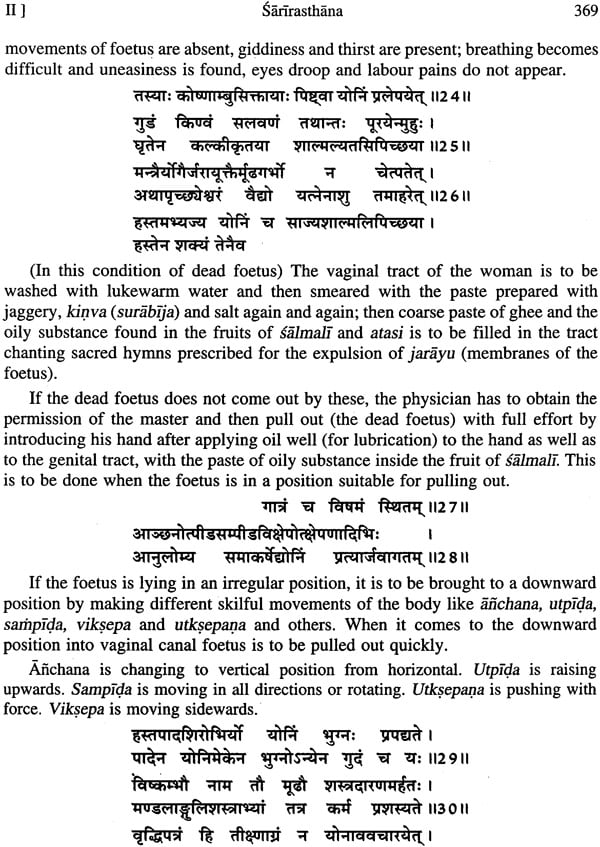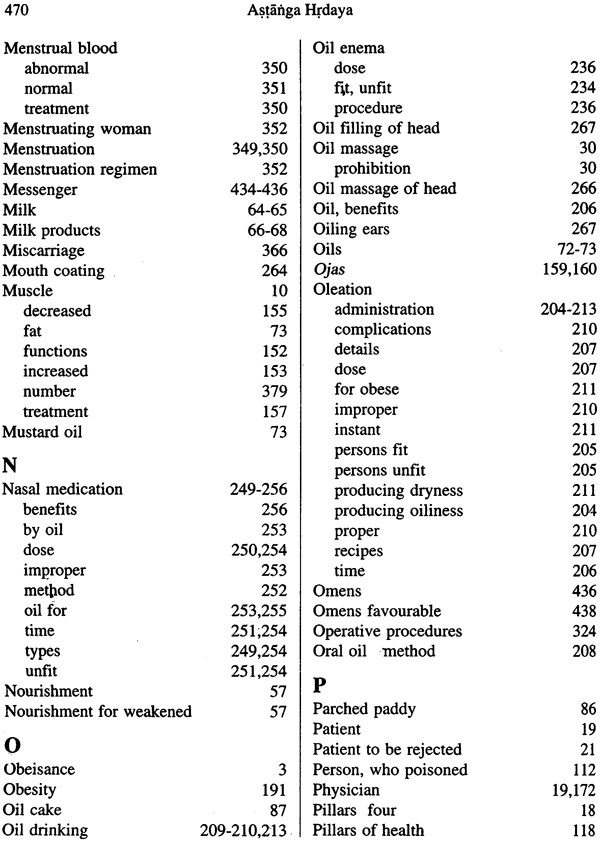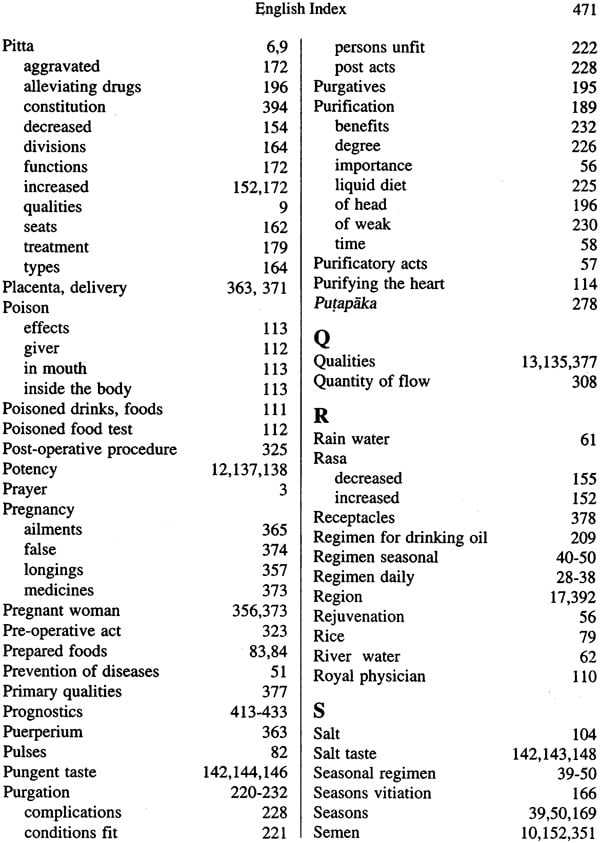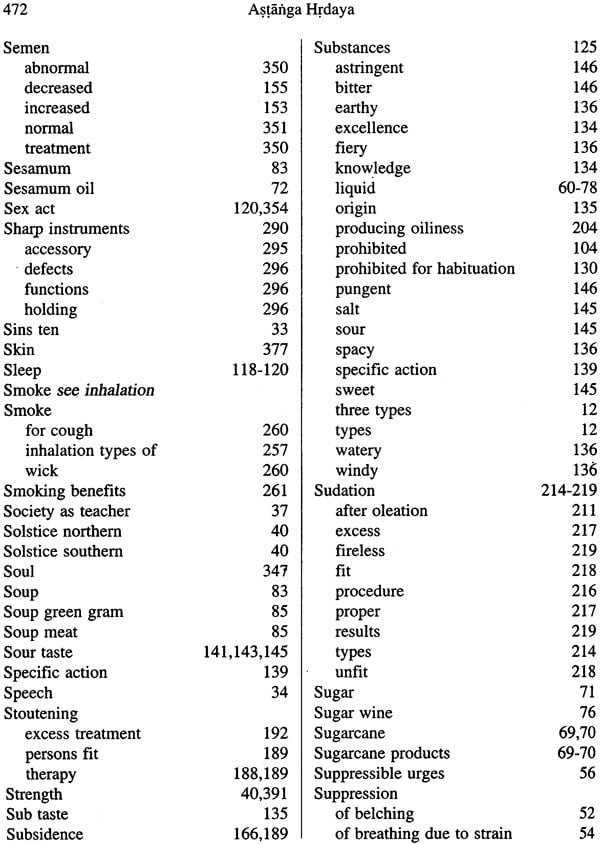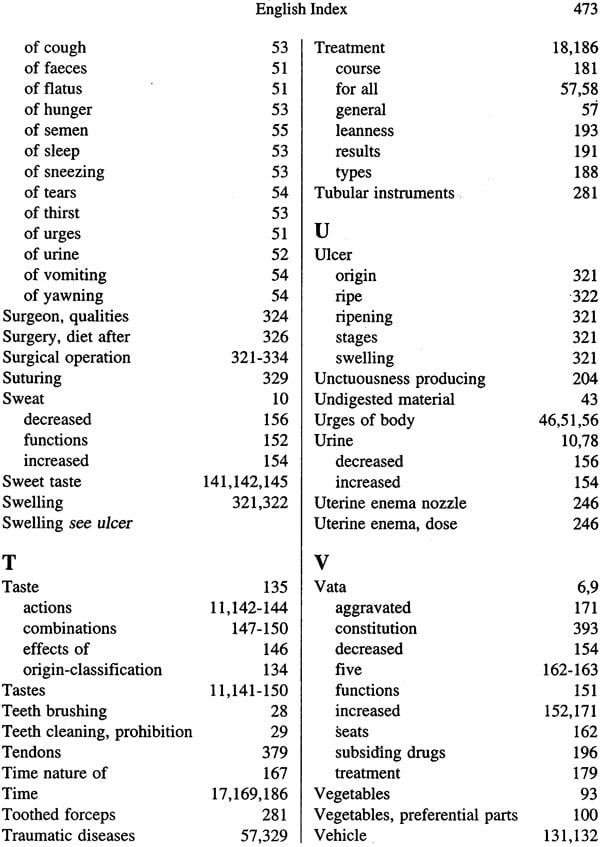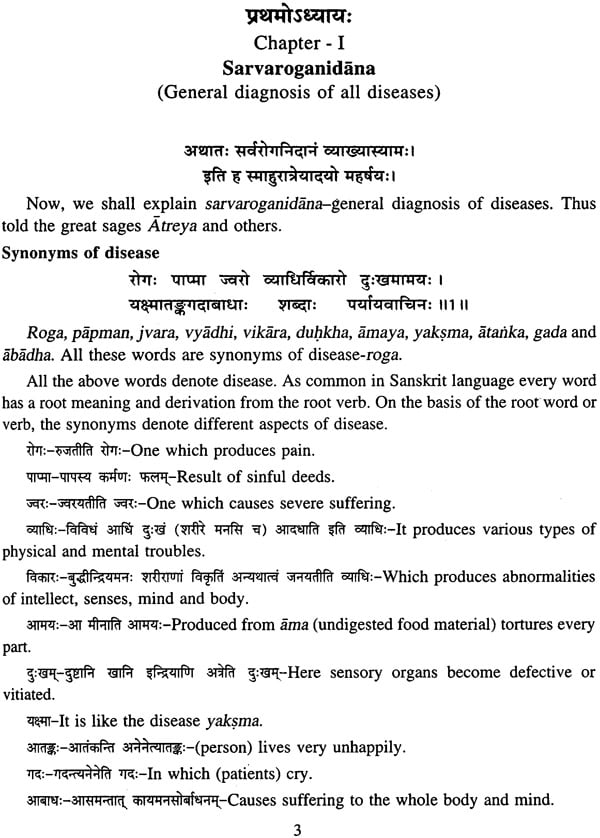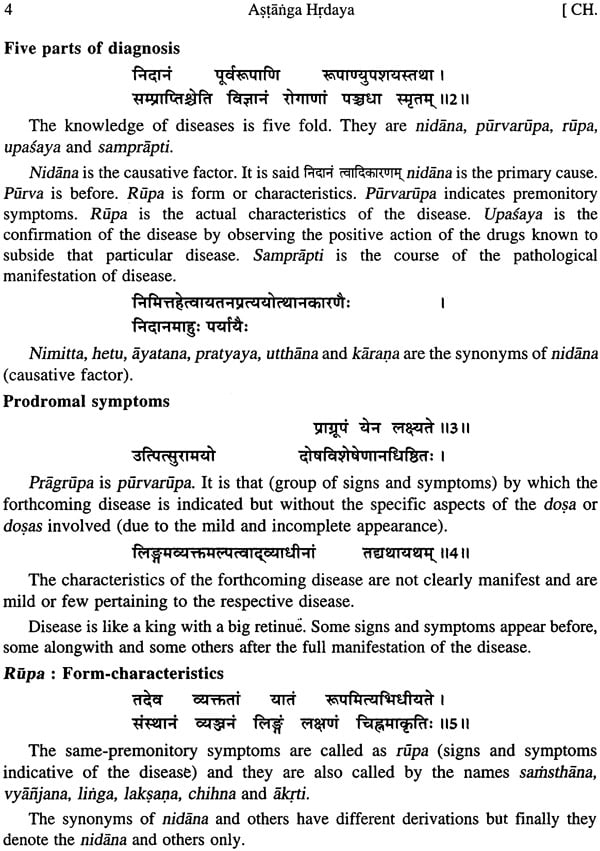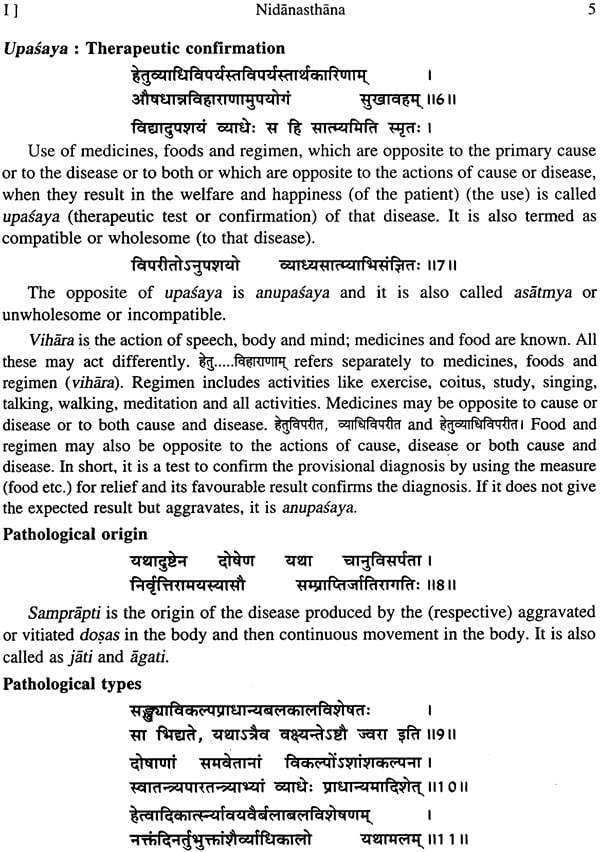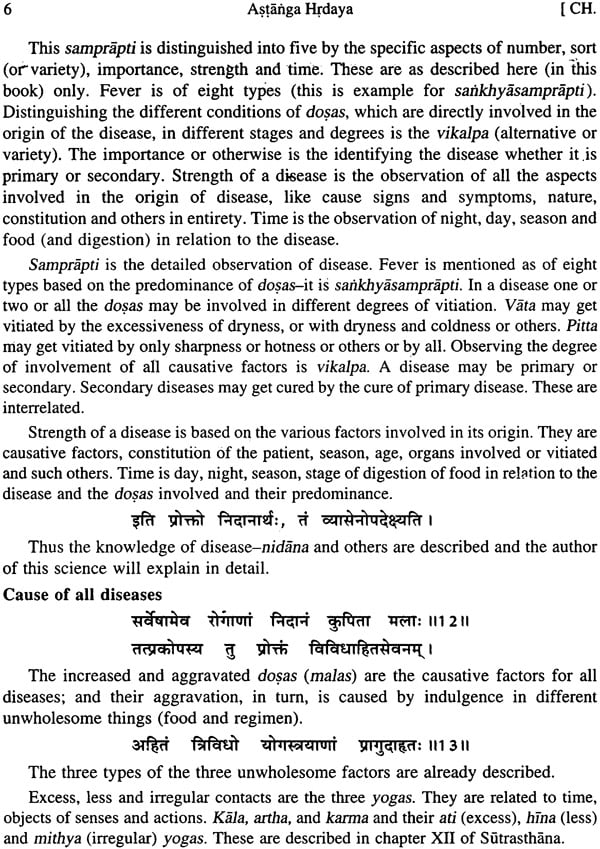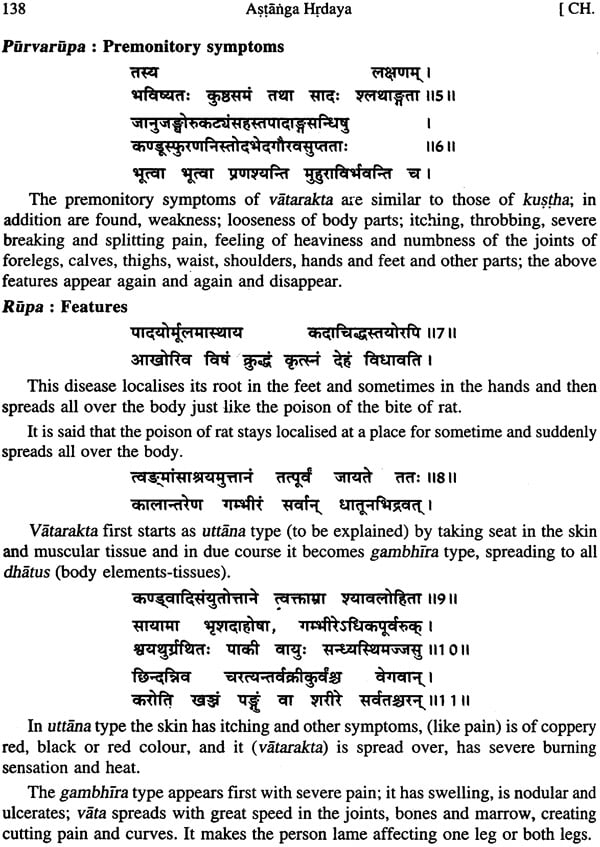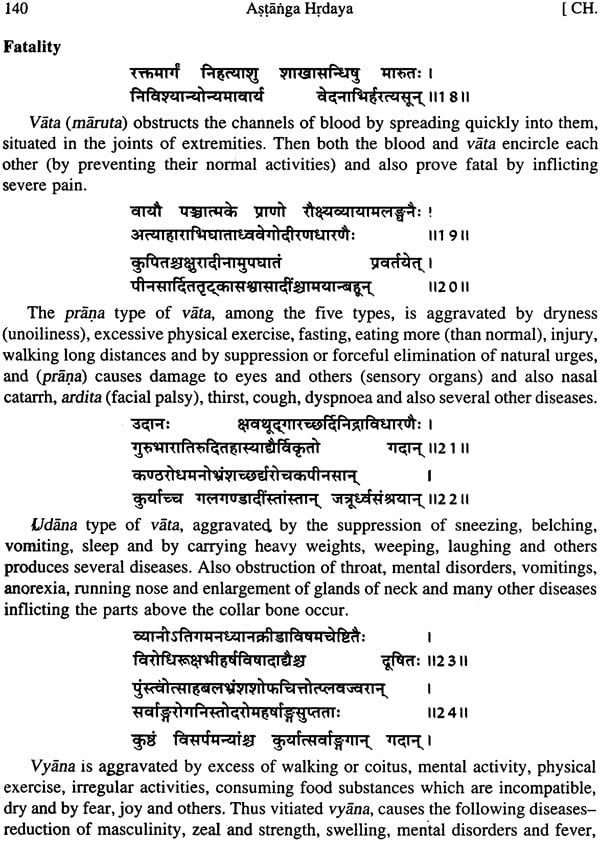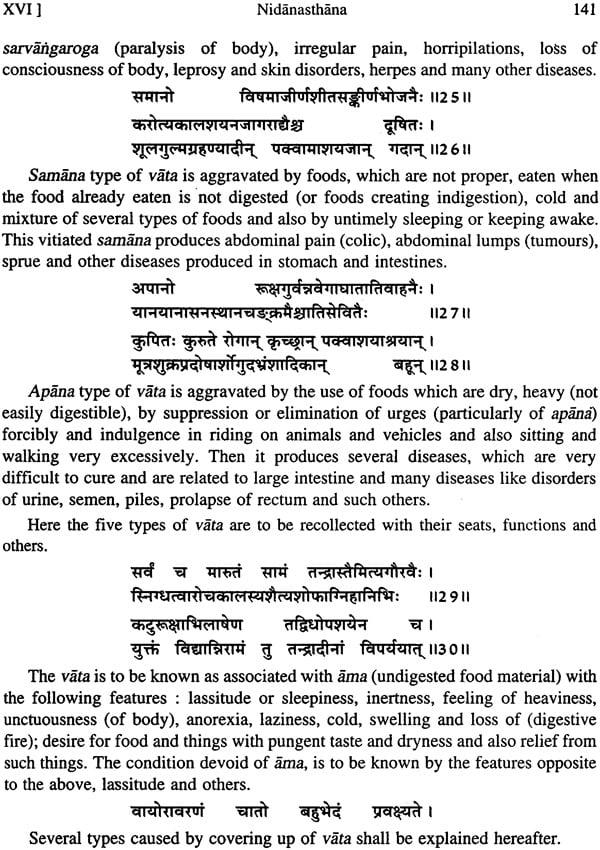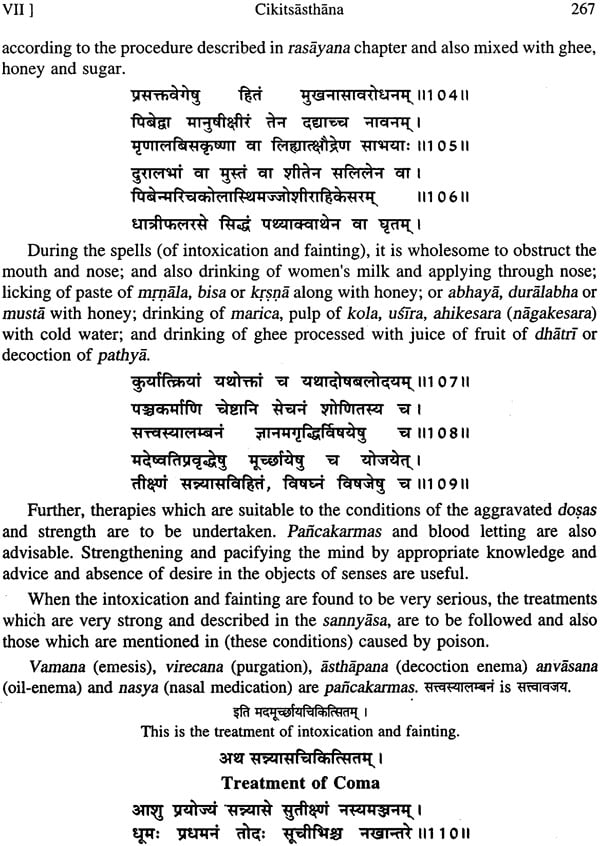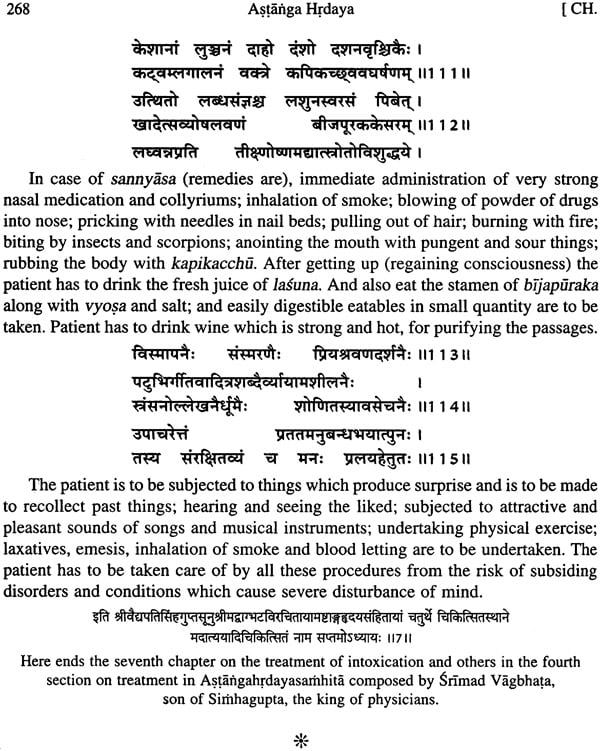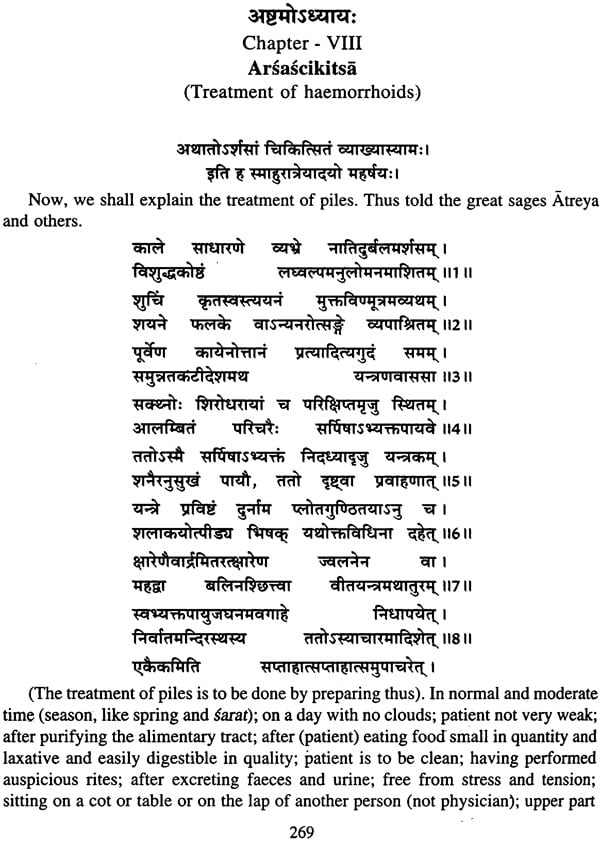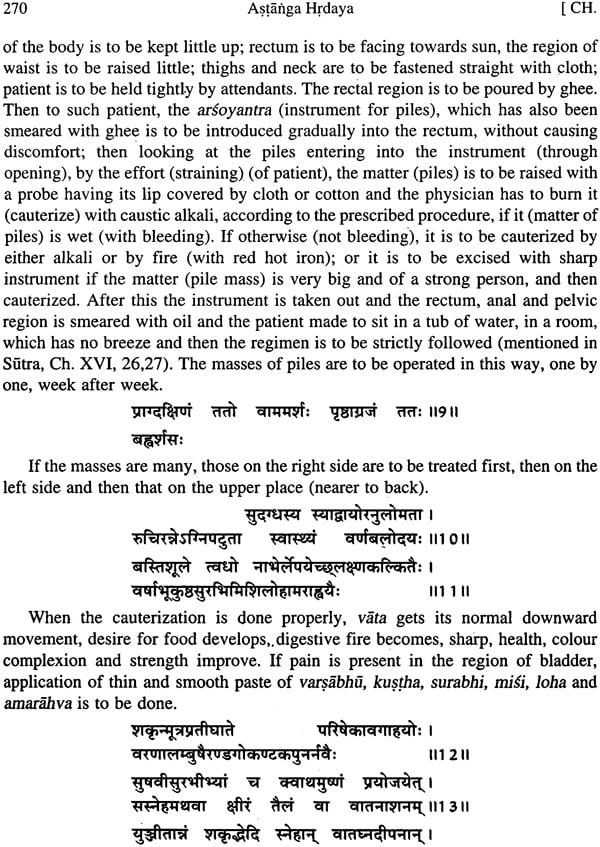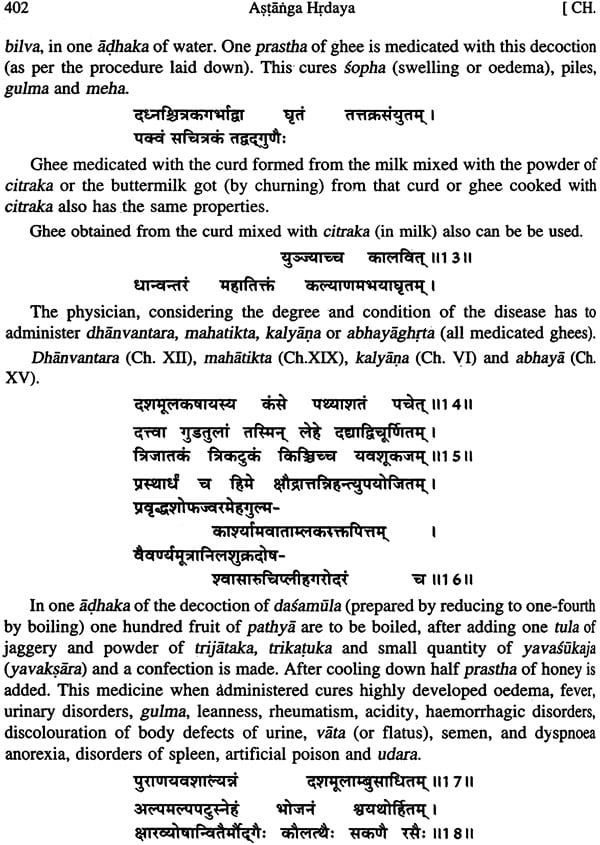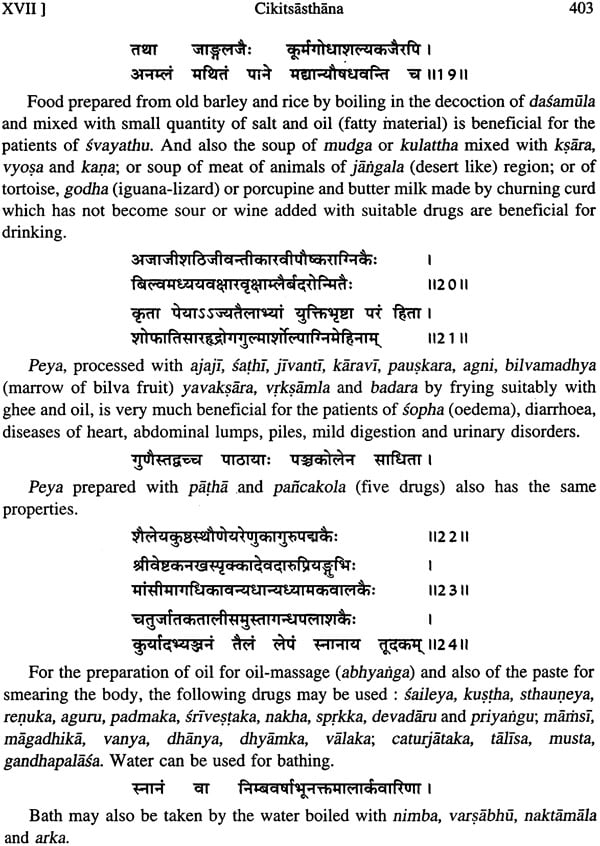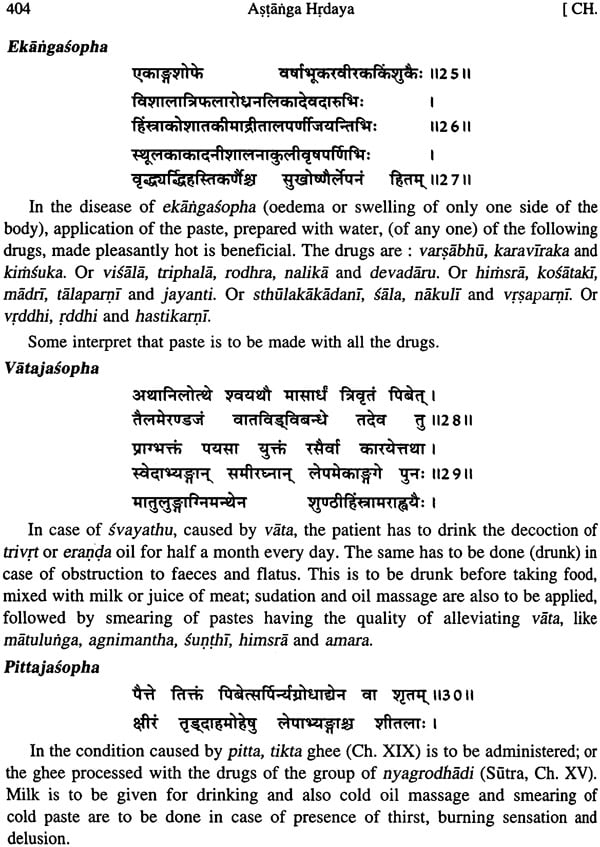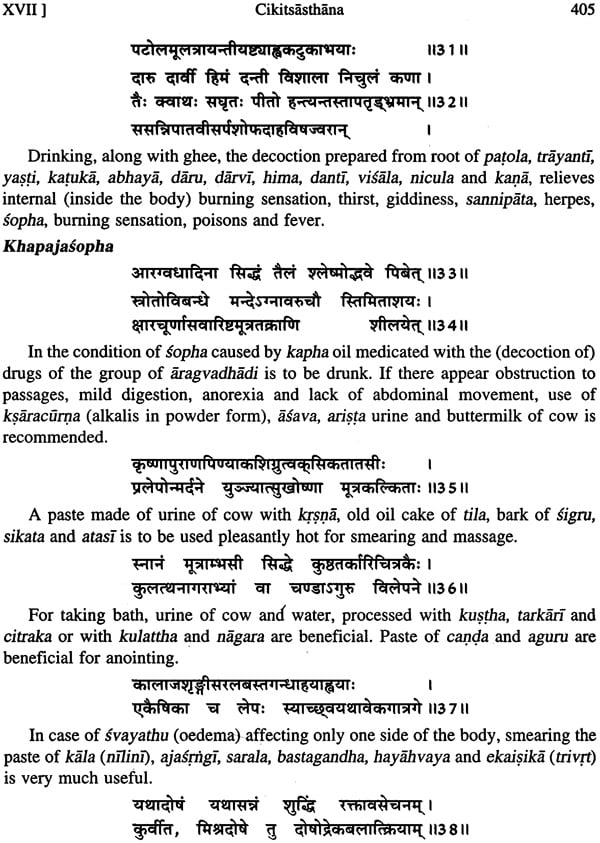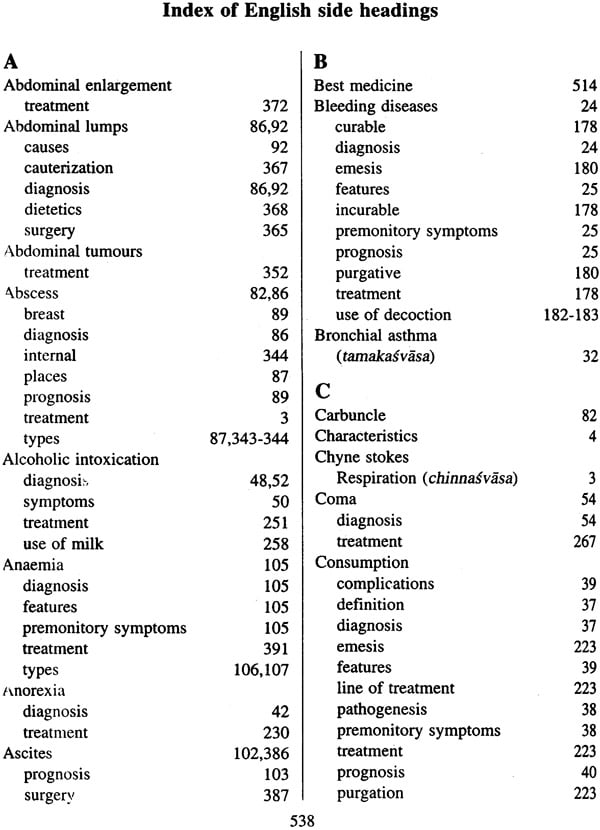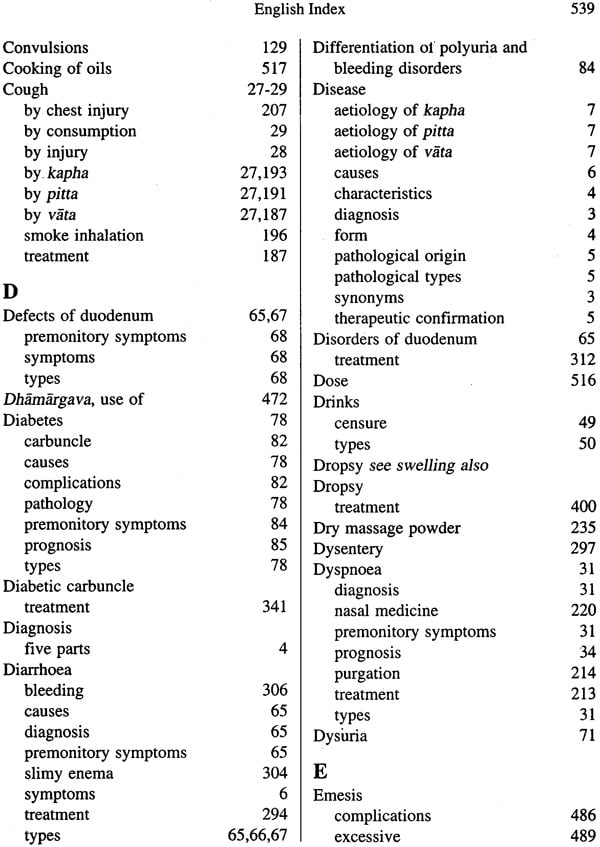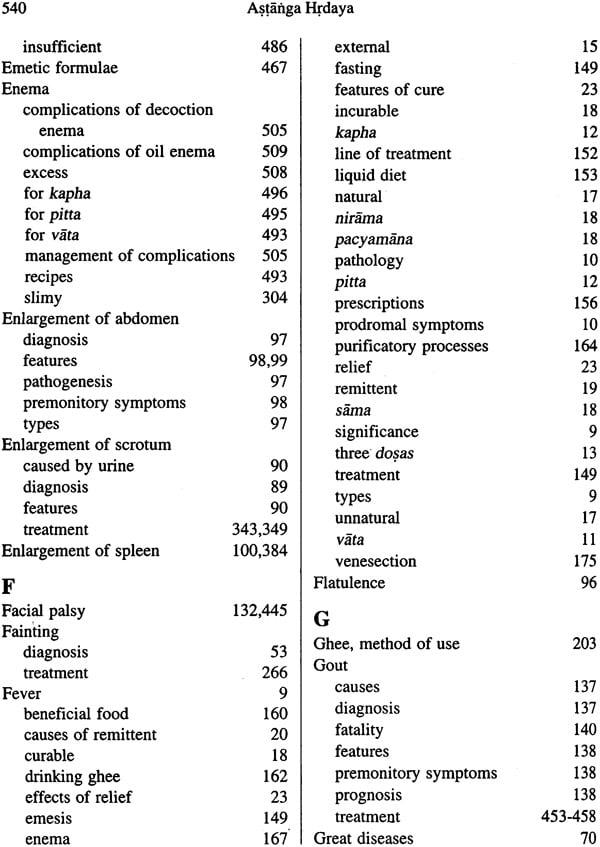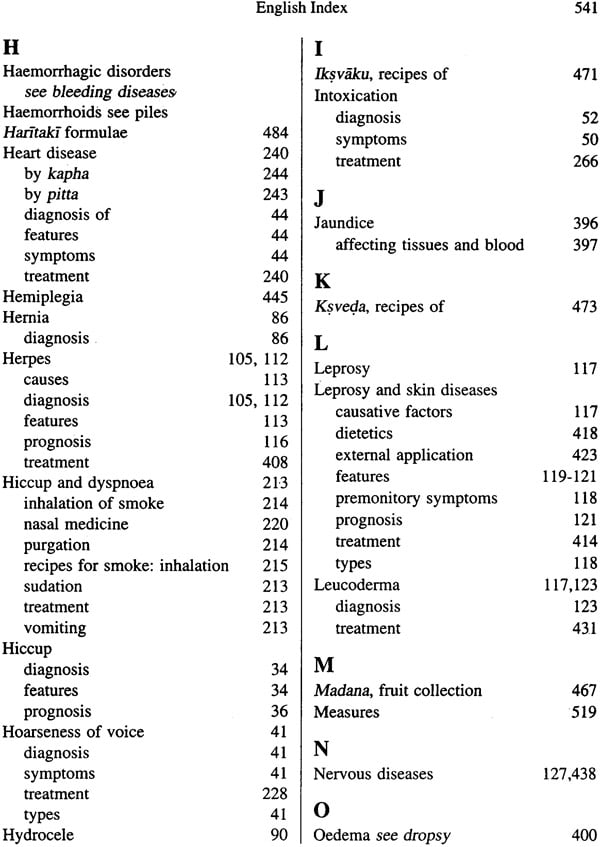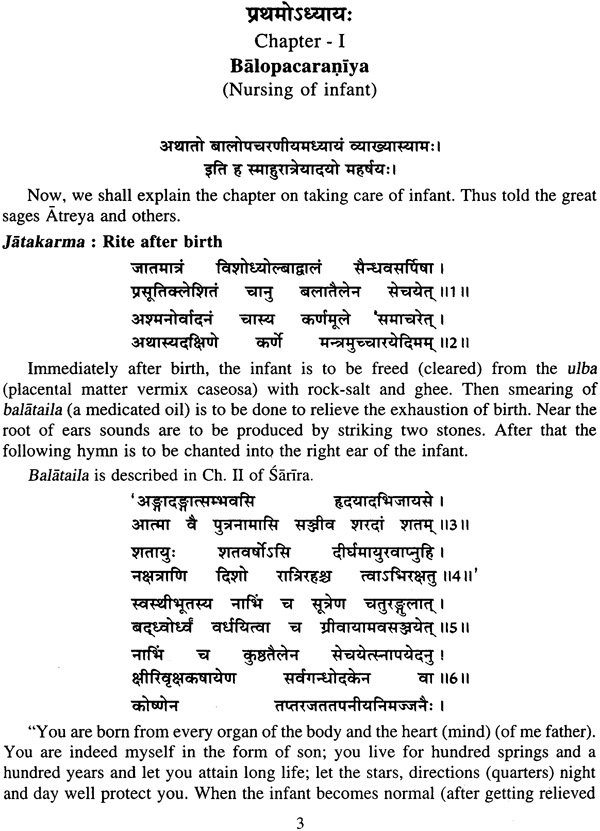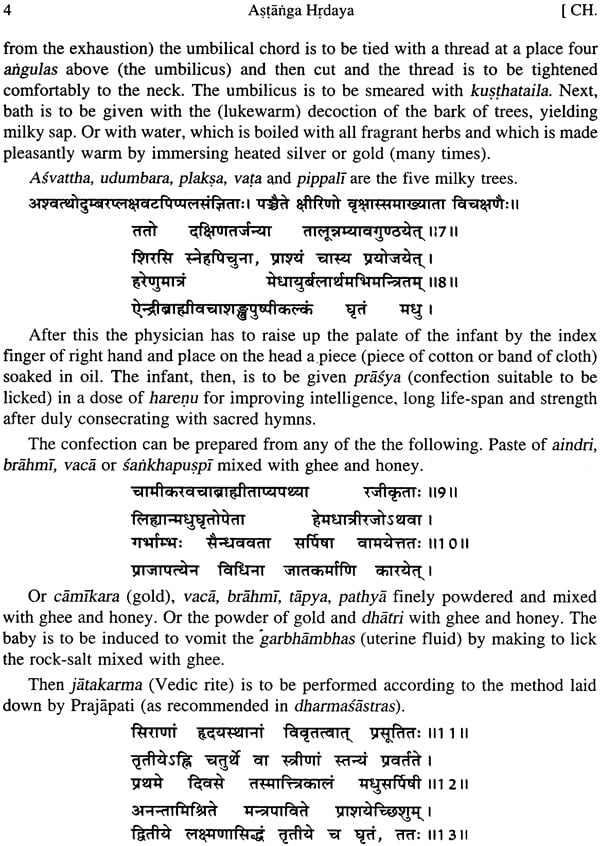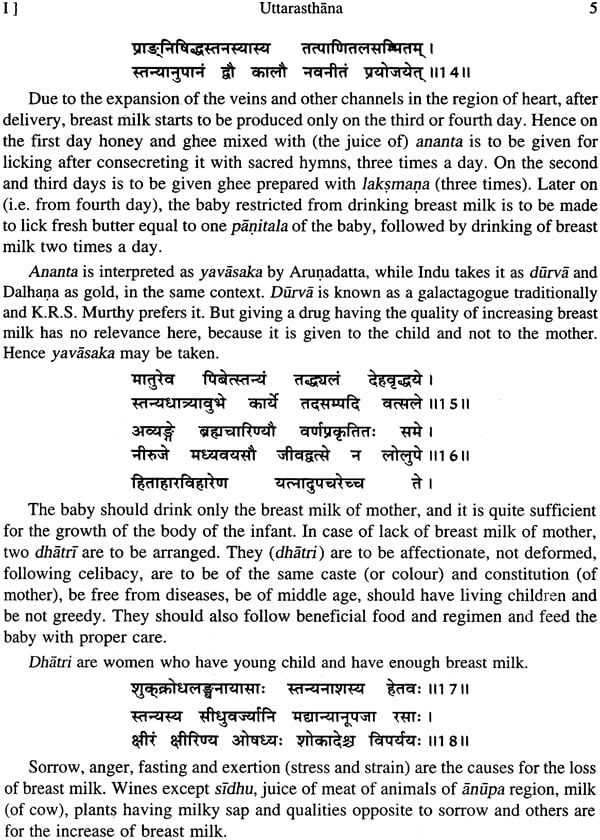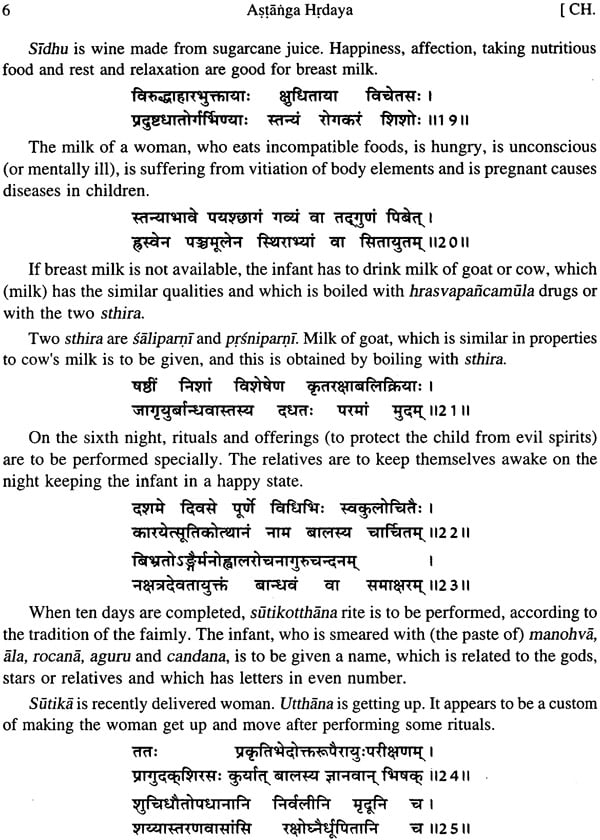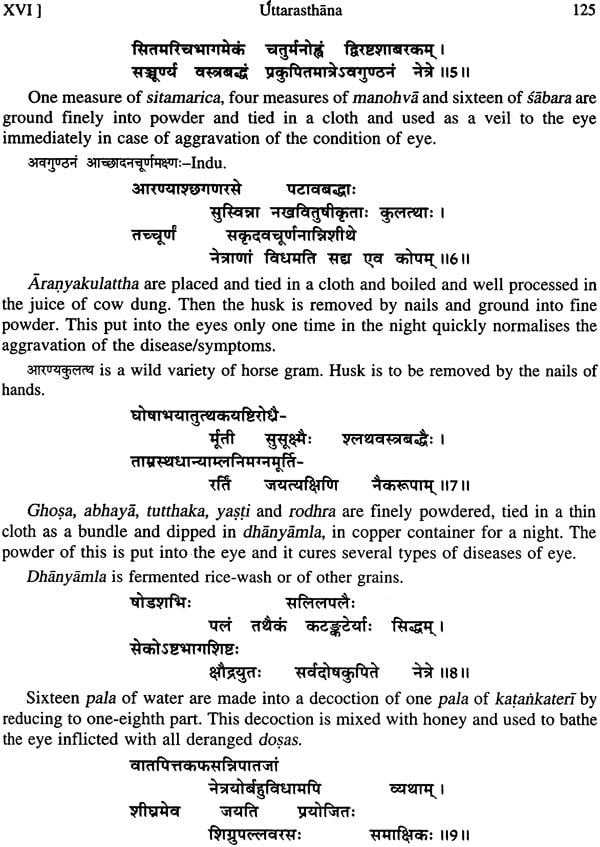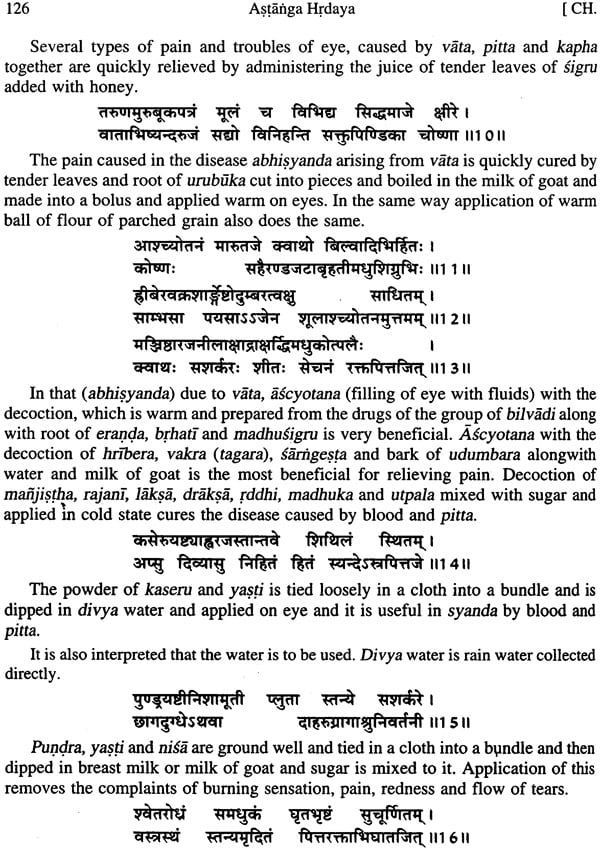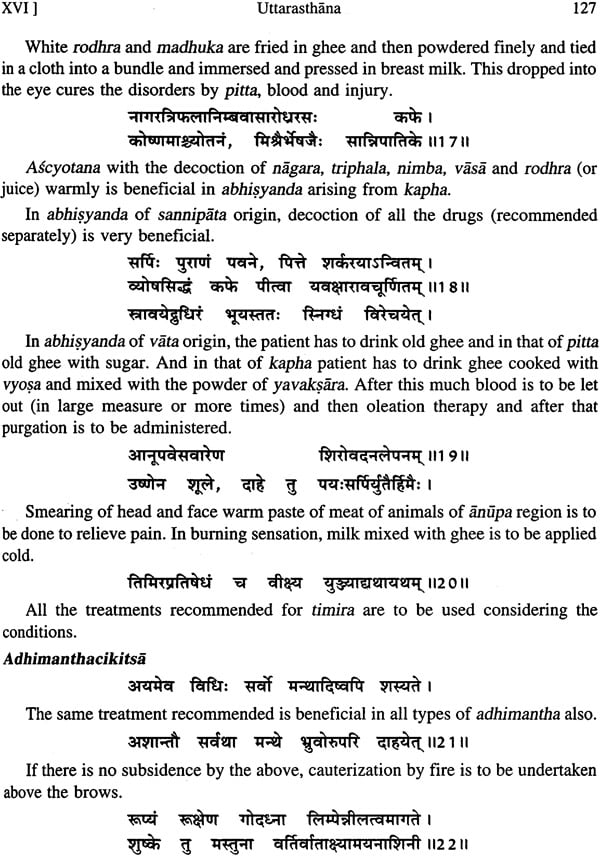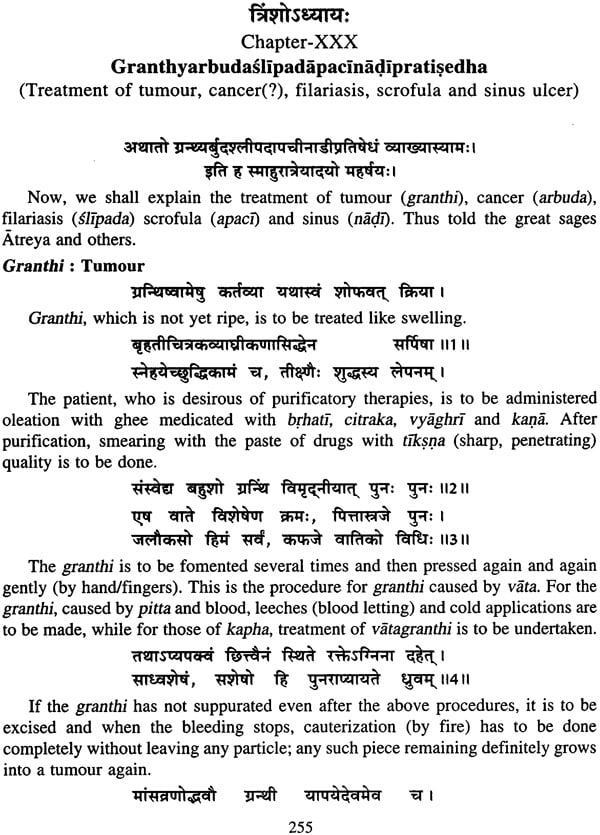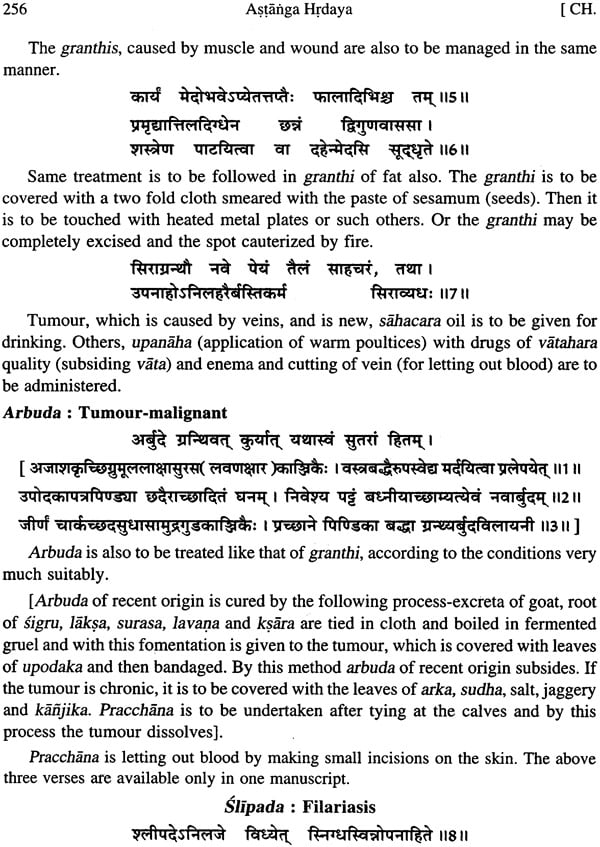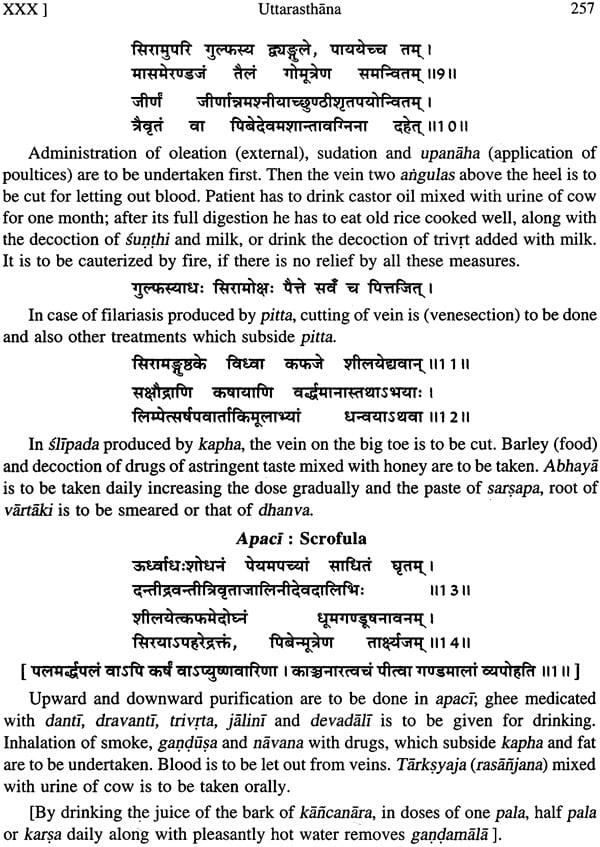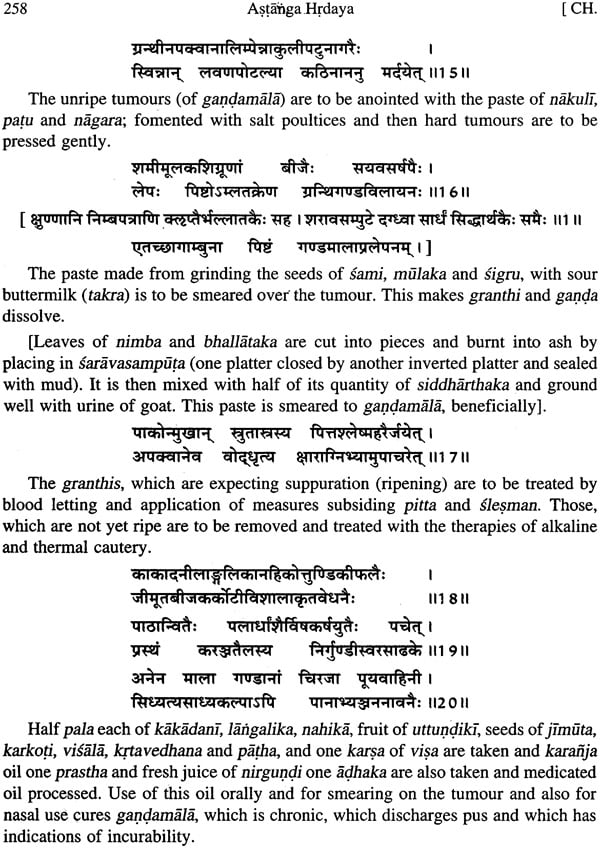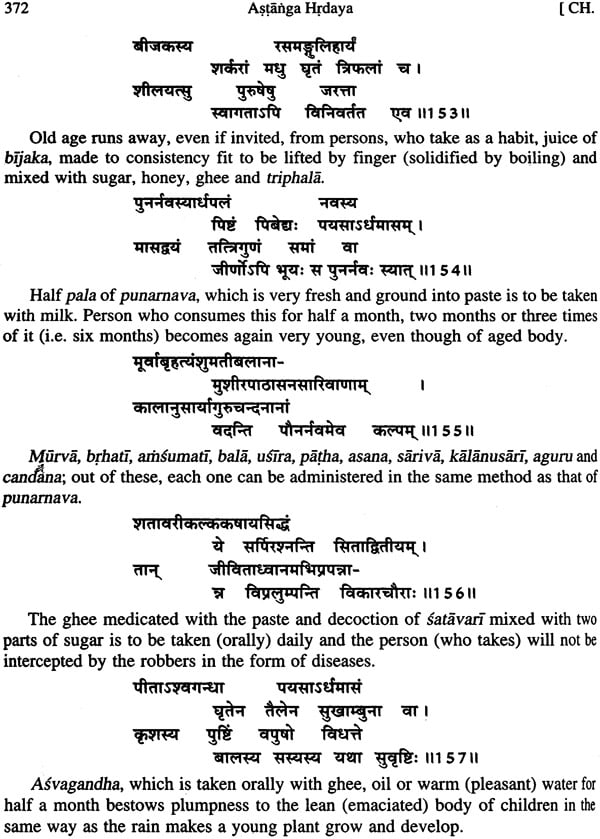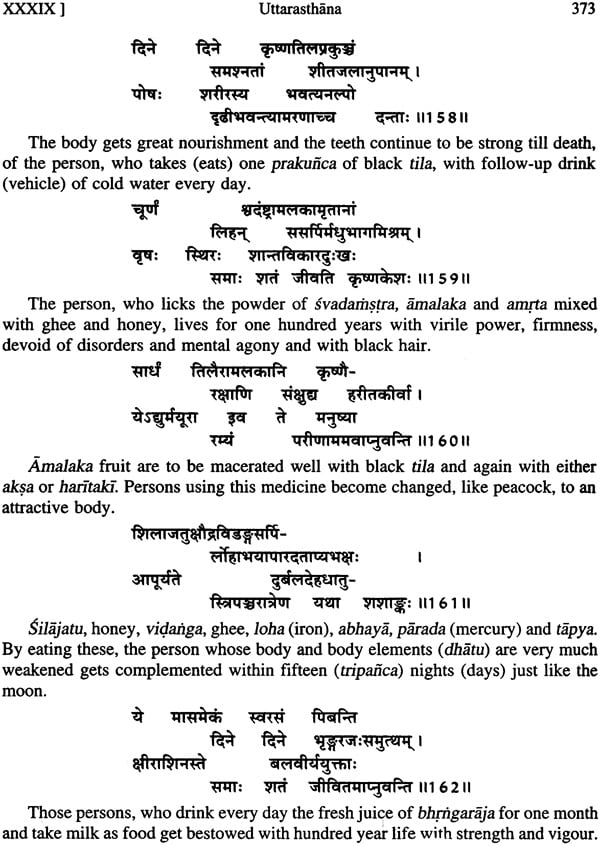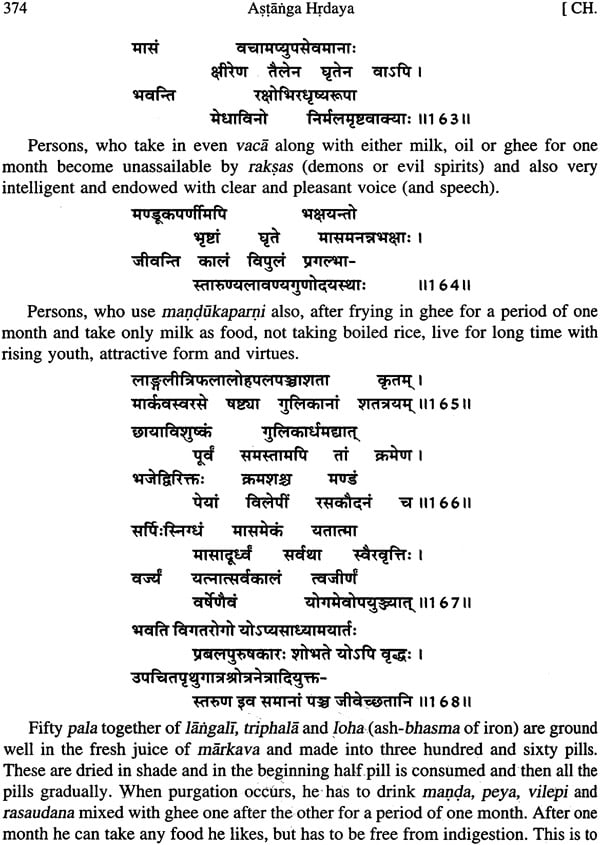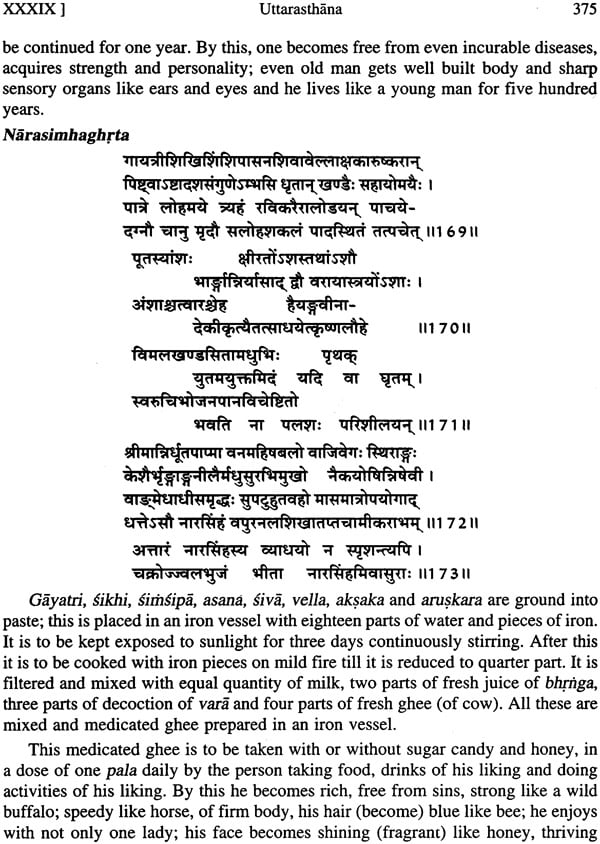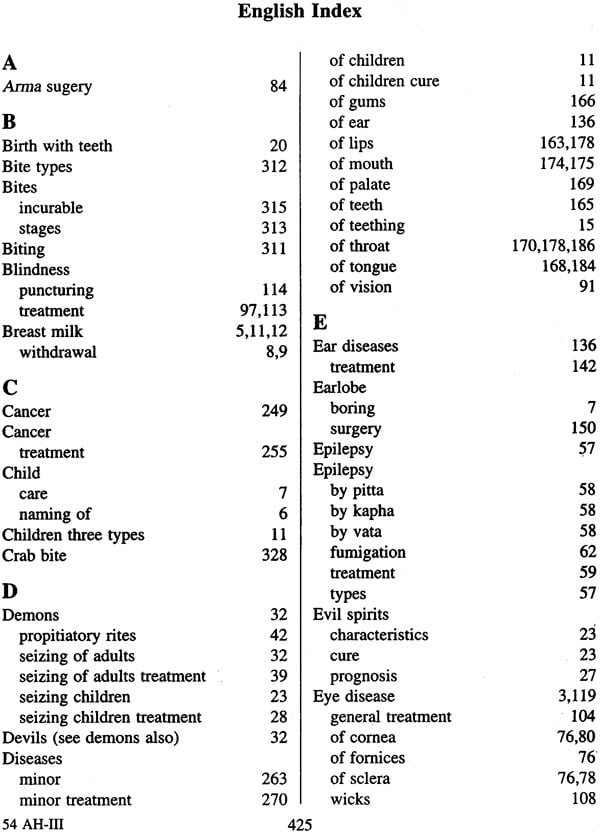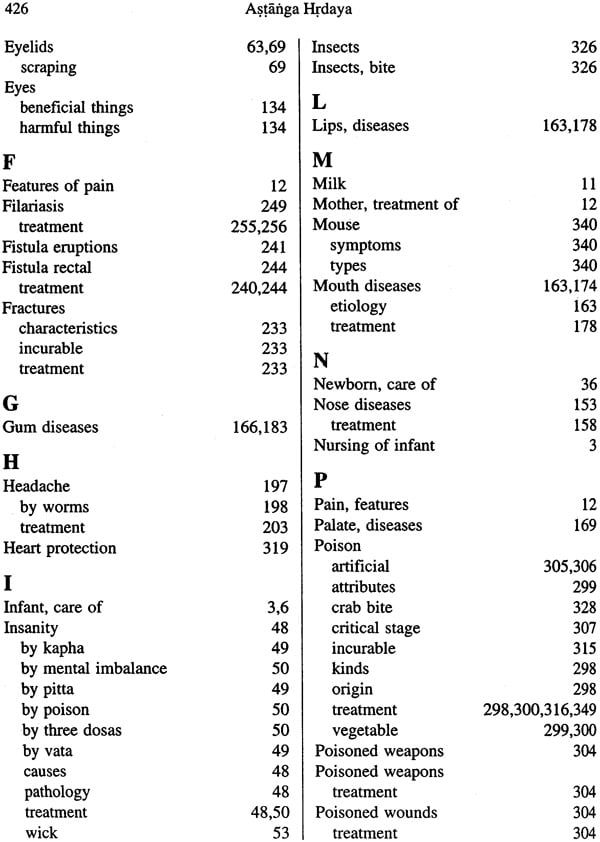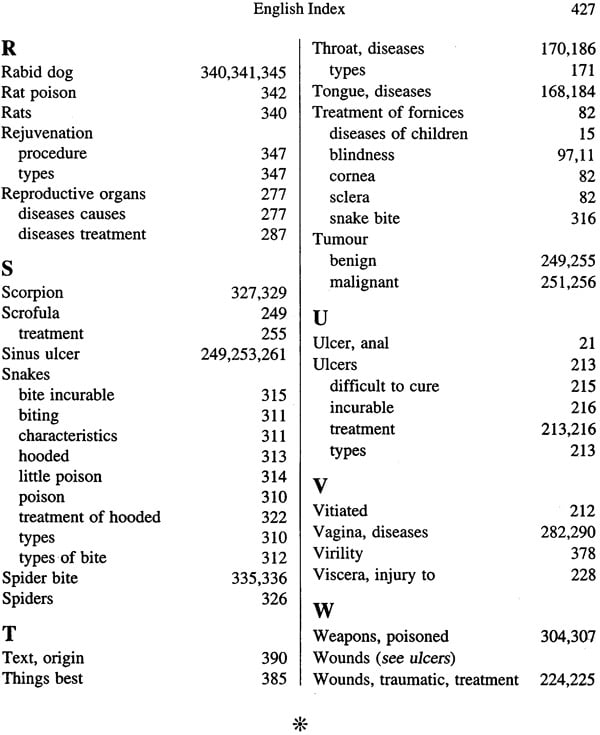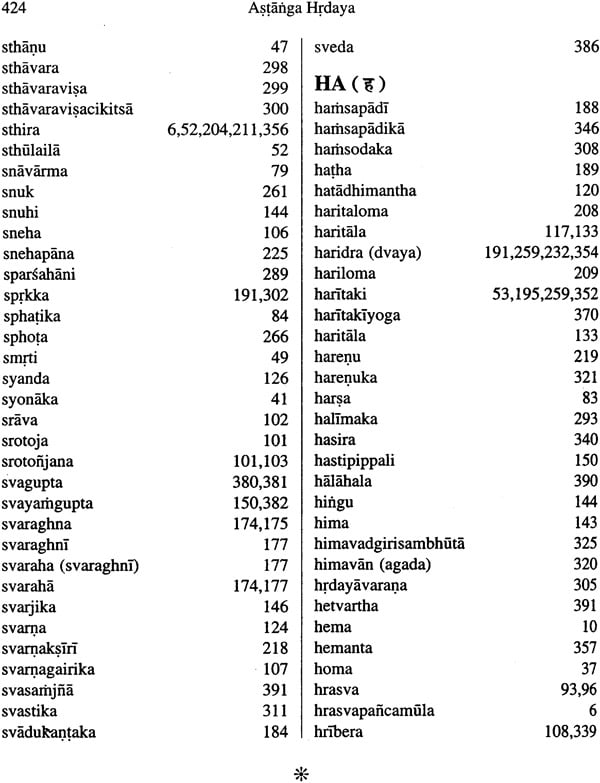
Astanga Hrdaya of Vagbhata - Sutrasthana, Sarirasthana, Nidanasthana, Cikitsasthana, Kalpasiddhisthana and Uttarasthana (Set of Three Volumes)
Book Specification
| Item Code: | NAM765 |
| Author: | Dr. B. Rama Rao |
| Publisher: | Chaukhambha Visvabharati , Varanasi |
| Language: | Sanskrit Text With English Translation |
| Edition: | 2016 |
| ISBN: | Volume. 1: 9789381301463 Volume. II: 9789381301517 Volume. III: 9789381301531 |
| Pages: | 1576 |
| Cover: | Paperback |
| Other Details | 9.5 inch X 7.5 inch |
| Weight | 2.50 kg |
Book Description
Ayurveda is now university and has spread to every corner of the world necessitating the publication of important Ayurvedic texts with English translation. The big trio and the small trio-brahattrayi and laghutrayi-are important and popular works of Ayurveda. Caraka Samhita. Susruta Samhita and Astanga Hrdaya are called brhattrayi. These classic works deal in detail with the fundamental principles, philosophical background and theoretical aspects of Ayurveda and among the three. Caraka Samhita and Susruta Samhita deal with stress on general medicine-kayacikitsa and surgery-salya respectively. The third Astanga Hrdaya deals with all the eight branches of Ayurveda with details required for Ayurveda scholars and practitioners. While Caraka Samhita and Susruta Samhita are in a mixture prose and verse, Astanga Hrdaya is in verse facilitating memorization. It has been very popular throughout India and also in other countries since its compilation. There are more than fifty commentaries in Sanskrit on Astanga Hrdaya, apart from those in regional languages showing its popularity, theoretical and practical value. The presentation of topics is neither too brief nor too elaborate and its appreciated by all.
Astanga Hrdaya is divided into sic sections-sthanas. I. Sutrasthana dealing with theoretical principles. 2. Sarirasthana-anatomy. 3. Nidana-diagnosis. 4. Cikitsa-treatment of general diseases. 5. Kalpasiddhi-preparation of recipes, purificatory procedures etc. 6. Uttarasthana-remaining seven branches. Thus all the subjects of Ayurveda are dealt with in 120 chapters in al lucid manner without complicated arguments and discussions.
Dr. Bhagavatam Rama Rao. Born in Medak (Telangana) in 1937 is a graduate in Ayurveda and Telugu and a post graduate is Sanskrit from Osmania University, Hyderabad. He is a profound scholar in Sanskrit, Telugu and Ayurveda an is also well versed in English and Hindi.
He worked for a long time in Indian Institute of History of Medicine, Hydrabad in different capacities and as director for more than two decades. During his tenure in IHM he contributed immensely for the development of the research activities and also of Museum and other pertaining to the history of Medicine in India in general history of Ayurveda in particular. He collected information relating to health and medicine from non-medical sources like kavyas, puranas, inscriptions, archaeological sources and traveller's accounts etc. He also served as the in charge of Dr. A. Lakshmipati Research Centre for Ayurveda and Literary Research Unit in Chennai retired as the Director of Indian Institute of Panchakarma in Kerala and thus gained experience in different fields of Ayurveda. He later worked as the principla of Dharma Ayurveda College, Sriperumbudur, Tamilnadu.
Another important contribution of Dr. Rao is the collection Another important contribution of Dr. Rao is the collection of information and study of palmleaf and paper manuscripts particularly of ayurveda in Sanskrit and Telugu. He brought to light several unknown valuable works on Ayurveda and allied subjects.
He is associated with many institutions like National Commission for History of Science, Editorial Boards of Indian Journal of History of Science, Research Council of Indian National Science Academy and Central Council for Research in Ayurvedic Sciences.
Astangahrdaya by Vagbhata is a popular treatise of Ayurveda. It is one of the three big compendia called Brhat-trayi, the other two being Carakasamhita and Susrutasamhita. Though ancient classics of Ayurveda deal with all branches and topics, it is that Carakassamhita predominantly deals with medical treatment while Susrutasamhita deals with salya or surgery. But Astangahrdaya, as the name itself suggests, explains all the eight branches and topics, with more stress on Sutrasthana (theories and fundamentals) in a lucid manner in verses to the extent required for a good practitioner.
In Indian literature, more than ten books are knows as composed by Vagbhata, Among them Vahatanighantu, Astangahrdaya, Astangasangraha, Vamanakalpa, Padrthacadrika, Vegbhatakosa and Rasaratnasamuccaya appear to Ayurveda works. Vagbhata I or Vrddhavagbhat, Vagbhata II or Vagbhata, Madhyavagbhata and Rasavagbhata are the four authors known in Ayurveda literature. Of the above four, Madhyavagbhata is knows from the quotations in Ratnaprabha commentary by Niscalakara of Cakradatta and there are no other evidences to support this. Rasavagbhata is the author of Rasaratnasamuccaya and is definitely different and later than the authors of Astangahrdaya and Astangasangraha, which are much earlier to Rasaratnasmuccaya. The identity of authors of Astangasangraha and Astangahrdya is controversial.
Both Astangasangraha and Astangahrdaya are popular works. Vagbhata, author of Astangasangraha states that he compiled the work as an essence of all earlier classics. He was te son of Simhagupta os Sindhu region. Father and grandfather of Vagbhata were also great Ayurvea scholars. Vagbhata of Astangahrdaya states that he compiled Astangahrdaya after churing the ocan of Ayurveda called Astangasangraha, indicating indirectly that he is the author of Astangasangraha also. Many similarities and identical passages are found in these two works apart from differences in some views. Thi led to the controversy about their identity. For detailed views as well as brief survey the following my be consulted:
1. Sarm, P.V. : Vagbhatavivecan-a comprehensive work on Vigbhata in Hindi by Prof. Priyavrat Sarma. It deals with all aspects of Astangasangraha, Astangahrdaya and Vagbhata based on internal and xted evidences; 1968, Varanasi.
2. Saema, P.V. (ed) : Jistory of Medicine in Indian, article on Vagbhata by B. Rama Rao, pp. 205-221, Indian National Science Academy, 1992, new Delhi.
3. Vogel, Caus : Vagbhata's Astamgahrdaya, English translation of Tibetan version Wiesbaden, 1965, Introduction.
4. Astangasangraha : Vol, English translation by K.R. Srikanthamurthy, Introduction; it briefly discusses all points regarding identity of both Vagbhatas, Astangasangraha and Astangahrdaya; Chaukhambha Orientalia, 2002, Vagbhatas, Astangasangraha and Astangahrdaya; Chaukhambha Orientalia, 2002, Varanasi.
The following verse of Astangahrdaya states that it is a summarized form of Astangasangraha : A big heap of nectar has been obtained in the form of Astangasangraha after churning the big ocean of with eight braches; from this a separate treatise has been evolved in the present forms and it is for it is for the satisfaction and pleasure of those who are capable of undertaking only limited efforts; but gives significant result. By this statement it is inferred that vagbhata Compiled both Astangahrdaya and Astangasangraha. A summary of different important views about the identity of both Vagbhatas in thus.
Points in support on the view that author of both the works is the same:
1. Both are sons of Simhahupta.
2. Language and style are similar.
3. Many identical passages occur in both works.
4. Arunadatta, Niscalakara, Candranandana, Indu and Bhattanarahari, the commentators treat both as one.
5. Author of Astangahrdaya mentions that it is a summarized version of Astangasangraha. This view is supported by scholars like Gannath sen, Haridatta Sastry, Moos, Meulenbeld, Paradkar and others.
Points supporting the view that both are different authors:
1. Information about the author is not given in Astangasangraha.
2. Language and style appear different and Astangahrdaya appears to be later age.
3. There is some dissimilarity in certain views and precepts.
4. Influence of Bhuddhism appears to be more in Astangahrdaya.
5. Astangahrdaya is only in verse while Astangasangraha is in verse and prose.
6. Vijayaraksita, Dalhana, Hemadri, Srikanthadatta and some others quotes verses from Astangasangraha referring the author as Vrddhavagbhata. This view is supported by Keith, P.K. Gode, Cordier, Cordier, Hariprapanna Sastry, P.V. Sarma and others.
Date
Astangahrdaya was popular not only in India but also in other countries. It was translated into Tibetan as early as 8th c. A.D. Muslim aatacks started from 7th c. A.D. onwards and after that hte possibility of compilation of such authoritative work in Sindh region was remote. Important evidence is the reference by the Chinese traveller Itsing. He mentioned that 'recently the eight branches medical system had been epitomized in one compilation', All agree that it refers to Astangahrdaya. Jejjata of 9thc. A.D. mentions himself as the disciple of vagbhata. Madhavanidana quotes from Astangahrdaya and this becomes the later limit i.e. 7thc. A.D. Both of these – Astangahrdaya and Madhavanidana – was were translated into Arabic in 8thc. A.D. Astangasangraha mentions Sakas at many places and Sakas ruled only up to the end of 4thc. A.D. The social, religious, political, literary and other aspects as gleaned from the works are Thus Astangahrdaya and Vagbhata can be placed in 6thc. A.D.
Commentaries
Among all Ayurveda classics Astangahrdaya appearts to be the work with number of commentaries. There are more than forty commentaries in Sanskrit and many more are found in regional languages. Among all the commentaries, Sarvangasundara of Arunadatta and Ayurvedarasayana by Hemadi are popular through out India. Some others are given below:
1. Sasilekha or Indumati by Indu. This has been published from Tripunithura by the Sanskrit College Committee, edited by K. Achyuta Poduval and C.K. Raman Nambiar.
2. Astangahrdayadipika by Udayadityabhatta.
3. Padarthacandrika by Candranandana.
4. Astangahrdayadipika by Hatakanka.
5. Vaiduryakabhasya by Vagbhata the Author himself.
6. Astangahrdayatika by Bhattaraharicandra.
7. Vijneyarthaprakasika by Visvesvarapandita.
8. Vagbhtakhandanamandana by Bhattanarahari.
| | ||
| Sutrasthana | ||
| 1 | Ayuskamiya adhyaya-desire for long life | 3 |
| 2 | Dinacarya adhyaya-daily regimen | 28 |
| 3 | Rtucarya adhyaya-seasonal regimen | 39 |
| 4 | Roganutpadaniya-prevention of diseases | 51 |
| 5 | Dravadravyavijnaniya-knowledge of liquid substances | 60 |
| 6 | Annasvarapavijnaniya-knowledge of nature of food material | 79 |
| 7 | Annaraksa adhyaya-protection of food material | 110 |
| 8 | Matrasitiya adhyaya-quantity of food | 123 |
| 9 | Dravyadivijnaniya-knowledge of substances and others | 134 |
| 10 | Rasabhediya-classification of tastes | 141 |
| 11 | Dosadivijnaniya-knowledge of dosas etc. | 151 |
| 12 | Dosabhediya-classification of dosas | 162 |
| 13 | Dosopakramaniya-treatment of dosas | 179 |
| 14 | Dvividhopakramaniya-two types of treatment | 188 |
| 15 | Sodhanadiganasangraha-groups of drugs for purification and others | 195 |
| 16 | Snehavidhi-administration of oleation | 204 |
| 17 | Svedavidhi-procedure of sudation | 214 |
| 18 | Vamanavirecanavidhi -procedure of emesis and purgation | 220 |
| 19 | Bastividhi-procedure of enema | 233 |
| 20 | Nasyavidhi-nasal medication | 249 |
| 21 | Dhumapanavidhi -procedure of inhaling smoke | 257 |
| 22 | Gandtisadividhi-procedure of gargle and others | 262 |
| 23 | Ascotananjanavidhi-procedure for eye-drops and eye-ointments | 269 |
| 24 | Tarpanaputapakavidhi-procedure of refreshing and cleaning eye | 275 |
| 25 | Yantravidhi-application of appliances and instruments | 280 |
| 26 | Sastravidhi-procedure of sharp instruments | 290 |
| 27 | Siravyadhavidhi-procedure of venesection | 302 |
| 28 | Salyaharanavidhi-procedure of extraction of foreign bodies | 311 |
| 29 | Sastrakarmavidhi-procedure of surgical operation | 321 |
| 30 | Ksaragnikarmavidhi-procedure of cautery by alkali and fire | 335 |
| Sarirasthana | ||
| 1 | Garbhavakranti-embryology | 347 |
| 2 | Garbhavyapad-ailments of pregnancy | 365 |
| 3 | Angavibhaga-different pacts of the body | 375 |
| 4 | Marrnavibhaga-classification of vital spots | 402 |
| 5 | Vikrtivijnaniya-knowledge of prognostics | 413 |
| 6 | Dutadivijnaniya-knowledge about messengers and others | 434 |
| Sanskrit Index | 445 | |
| English Index | 465 | |
| Glossary | 475 | |
| | ||
| Nidanasthana | ||
| 1 | Sarvaroganidana-general diagnosis of all diseases | 3 |
| 2 | Jvaranidana-diagnosis of fever | 9 |
| 3 | Raktapittakasanidana-diagnosis of bleeding disorders and cough | 24 |
| 4 | Svasahidhmanidana-diagnosis of dyspnoea and hiccup | 31 |
| 5 | Rajayaksmadinidana-diagnosis of pulmonary tuberculosis and others | 37 |
| 6 | Madatyayadinidana-diagnosis of alcoholic intoxication and others | 48 |
| 7 | Arsonidana-diagnosis of haemorrhoids or piles | 56 |
| 8 | Atisaragrahanidosanidana-diagnosis of diarrhoea and disorders of duodenum | 65 |
| 9 | Mutraghatanidana-diagnosis of retention of urine | 71 |
| 10 | Pramehanidana-diagnosis of polyuria and diabetes | 78 |
| 11 | Vidradhivrddhigulmanidana-diagnosis of abscess, hernia and abdominal lumps | 86 |
| 12 | Udaranidana-diagnosis of enlargement of abdomen | 97 |
| 13 | Pandurogasophavisarpanidana-diagnosis of anaemia, swelling and herpes | 105 |
| 14 | Kusthasvitrakrminidana-diagnosis of leprosy, leucoderma and worms infestation | 117 |
| 15 | Vatavyadhinidana-diagnosis of diseases caused by vata | 127 |
| 16 | Vatasonitanidana-diagnosis of gout | 137 |
| Cikitsasthana | ||
| 1 | Jvaracikitsa-treatment of fever | 149 |
| 2 | Raktapittacikitsa-treatment of haemorrhagic diseases | 178 |
| 3 | Kasacikitsa-treatment of cough | 187 |
| 4 | Svasahidhmacikitsa-treatment of dyspnoea and hiccup | 213 |
| 5 | Rajayaksmadicikitsa-treatment of pulmonary tuberculosis and others | 223 |
| 6 | Chardihrdrogatrsnacikitsa-treatment of vomiting, heart diseases and thirst | 237 |
| 7 | Madatyayadicikitsa-treatment of alcoholic intoxication and others | 251 |
| 8 | Arsascikitsa-treatment of haemorrhoids | 269 |
| 9 | Atisaracikitsa-treatment of diarrhoea | 294 |
| 10 | Grahanidosacikitsa-treatment of sprue/duodenal disorders | 312 |
| 11 | Mutraghatacikitsa-treatment of retention of urine | 326 |
| 12 | Pramehacikitsa-treatment of urinary disorders | 336 |
| 13 | Vidradhivrddhicikitsa-treatment of abscess and scrotal enlargement | 343 |
| 14 | Gulmacikitsa-treatment of abdominal tumours | 352 |
| 15 | Udaracikitsa-treatment of abdominal enlargement | 372 |
| 16 | Pandurogacikitsa-treatment of anaemia | 391 |
| 17 | Swayathucikitsa-treatment of dropsy | 400 |
| 18 | Visarpacikitsa-treatment of herpes | 408 |
| 19 | Kusthacikitsa-treatment of leprosy and skin diseases | 414 |
| 20 | Svitrakrmicikitsa-treatment of leucoderma and worms | 431 |
| 21 | Vatavyadhicikitsa-treatment of diseases caused by vata | 438 |
| 22 | Vatasonitacikitsa-treatment of gout | 453 |
| Kalpasiddhisthana | ||
| 1 | Vamanakalpa-emetic formulae | 467 |
| 2 | Virecanakalpa-formulae for purgation | 476 |
| 3 | V amanavirecanavyapatsiddhikalpa- management of complications of emesis and purgation | 486 |
| 4 | Bastikalpa-recipes for enema | 493 |
| 5 | Bastivyapatsiddhikalpa-management of complications of enema | 505 |
| 6 | Dravyakalpa-pharmaceuticals | 514 |
| Sanskrit Index | 521 | |
| Index of English side headings | 538 | |
| Glossary | 544 | |
| | ||
| Uttarasthana | ||
| II. | Paediatrics-kaumararanrra | |
| Balopacaraniya-nursing of infant | 3 | |
| Balamayapratisedha-cure of diseases of children | 11 | |
| Balagrahapratisedha-cure of evil spirits on children | 23 | |
| III. | Possession by evil spirits or psychological disorders-bbutavijuaniya | |
| Bhutvijnaniya-knowledge of devils/demons | 32 | |
| Bhutapratisedha-treatment of demons | 39 | |
| Unmadapratisedha-treatment of insanity | 48 | |
| Apasrnarapratisedha-treatment of epilepsy | 57 | |
| III. | IV. Section on upper part-salakya | |
| Vartmarogavijnaniya-knowledge of diseases of eyelids | 63 | |
| Vartmarogapratisedha-treatment of diseases of eyelids | 69 | |
| Sandhisitasitarogavijfinlya-knowledge of diseases of fornices, sclera and cornea | 76 | |
| Sandhisitasitarogapratisedha-treatment of deseases of fornices, sclera and cornea | 82 | |
| Drstirogavijnaniya-knowledge of diseases of vision | 91 | |
| Timirapratisedha-treatment of blindness | 97 | |
| Linganasapratisedha-treatment of blindness | 113 | |
| Sarvaksirogavijnaniya-knowledge of diseases of complete eye | 119 | |
| Sarvaksirogapratisedha-treatment of diseases of complete eye | 124 | |
| Karnarogavijnaniya-knowledge of the diseases of the ear | 136 | |
| Karnarogapratisedha-treatrnent of the diseases of the ear | 142 | |
| Nasarogavijnaniya-knowledge of diseases of nose | 153 | |
| Nasarogapratisedha-trearment of diseases of nose | 158 | |
| Mukharogavijnaniya-knowledge of diseases of mouth | 163 | |
| Mukharogapratisedha-treatment of diseases of mouth | 178 | |
| Sirorogavijnaniya-knowledge of diseases of head | 197 | |
| Sirorogapratisedha-treatment of diseases of head | 203 | |
| V. | Surgical section-salyatantra | |
| Vranapratisedha-treatment of wounds/ulcers | 213 | |
| Sadyovranapratisedha-treatmment of traumatic wounds | 224 | |
| Bhangapratisedha-treatment of fractures | 233 | |
| Bhagandarapratisedha-treatment of fistula (rectal) | 240 | |
| GranthyarbudaslipadapacInadivijfiyanlya-knowledge of tumour, cancer(?), filariasis, scrofula and sinus ulcer | 249 | |
| Granthyarbudaslipadapaclnadipratisedha-treatment of tumour, cancer(?), filariasis, scrofula and sinus ulcer | 255 | |
| Ksudrarogavijnaniya-knowledge of minor diseases | 253 | |
| Ksudrarogapratisedha-treatment of minor diseases | 270 | |
| Guhyarogavijnaniya-knowledge of diseases of reproductive organs (private parts) | 277 | |
| Guhyarogapratisedha-treatment of diseases of genital organs | 287 | |
| VI. | Toxicology-visetan tra | |
| Visapratisedha-treatment of poisons | 298 | |
| Sarpavisapratisedha-treatrnent of snake poison | 310 | |
| Kltalutadivisapratisedha-Remedy for poison of insects, spiders and others | 326 | |
| Musikalarkavisapratisedha-treatment of poison of mouse and rabid dog bite | 340 | |
| VII. | Rejuvenation-rasayana | |
| Rasayanavidhi-procedure of rejuvenation | 347 | |
| VIII. | Aphrodisiacs-vajfkarana | |
| Vajikaranavidhi-methods of improving virility | 378 | |
| Sanskrit Index | 396 | |
| English Index | 425 | |
| Glossary | 428 | |
| Appendix 1: | Some verses of Literary interest | 468 |
| Appendix 2: | Commentaries on Astanga Hrdaya | 469 |
| Appendix 3: | Authors quoted in Astanga Hrdaya | 271 |
| Appendix 4: | Recipes in Astanga Hrdaya | 472 |
